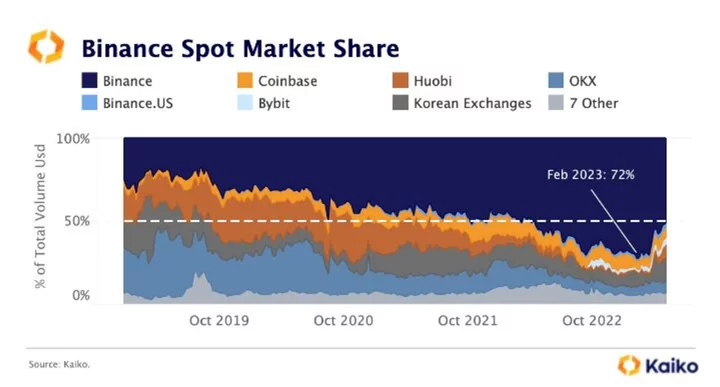Binance appears to have lost market share amid changes to its trading-fee structure and a wider regulatory crackdown on the cryptocurrency universe by US officials.
The world’s largest digital trading platform now commands about 50% of spot market share, the lowest since April 2022, according to Dessislava Ianeva, senior research analyst at Kaiko. Its market share has fallen off after the platform, which has no fixed headquarters and offers services around the world, in March removed zero-fee trading on certain pairs.
“We have to wait and see whether this is temporary or a more sustainable shift in trading patterns,” Ianeva said, adding that she’s noticed that some Korean exchanges have seen upticks at the same time, though it’s not possible to directly determine whether that increase is due to outflows from Binance.
“It’s possible that — due to the current regulatory environment — some institutions are taking a wait-and-see approach, staying out of the market, or deploying less funds to other trading venues,” Ianeva said.
Binance did not immediately respond to a request for comment.
Crypto market-watchers have been super focused on trading volumes and liquidity in markets, as many investors — retail and institutions — have fled in the wake of FTX’s collapse at the end of last year. In March, the US Commodity Futures Trading Commission sued Binance for breaking American derivatives rules. Binance has disputed the allegations.
Other negative events have also been a factor in many previously engaged investors shunning crypto, at least for now. And some firms are scaling back their involvement in digital-assets markets: Jane Street Group and Jump Crypto — two of the world’s top market-making firms — are pulling back from trading digital assets in the US as regulators crack down on the industry, Bloomberg News reported.
In April, combined spot and derivatives trading volumes on centralized exchanges dropped nearly 30% to $2.8 trillion, according to CCData. That marked the first month-over-month fall in trading volumes this year.
Ianeva also points out that Bitcoin liquidity on Binance has steadily declined in recent months, and has more than halved since the start of February. “Volume is also down, but the decline was mainly driven by the removal of BTC’s zero fees on March 22,” she said. Meanwhile, Bitcoin on Wednesday fell below $27,000 as some analysts pointed to low liquidity that can make prices swing around.
Binance, the world’s largest crypto exchange, last year introduced zero-fee trading on a number of market pairs. That helped it gain more than 20% in market share, according to Kaiko. But in March of this year, the exchange halted that offer for 13 Bitcoin trading pairs (though it allowed it for Bitcoin-TrueUSD). Meanwhile, US regulators have been very focused on cracking down on certain activities in the space.
Its market share turned when it removed those zero-fee options, says Noelle Acheson, author of the “Crypto Is Macro Now” newsletter.
“The speed of the decline in BTC spot volumes on Binance shows just how speculative much of the exchange’s volumes were,” she said. “This makes sense, since fees are one of the few barriers for trading churn.”
Acheson added: “While a drop in volumes is usually not a good sign for a market, in this case it signals less speculative churn, which is healthier.”
--With assistance from Muyao Shen and Olga Kharif.

